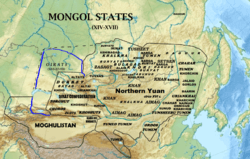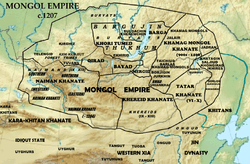Barga Mongols
The Barga (Mongol: Барга; simplified Chinese: 巴尔虎部; traditional Chinese: 巴爾虎部; pinyin: Bā'ěrhǔ Bù) are a subgroup of the Mongol people which gave its name to the Baikal region – "Bargujin-Tukum" (Bargujin Tökhöm) – "the land's end", according to the 13th-14th centuries Mongol people's conception.[2]
 Location of the Barga | |
| Regions with significant populations | |
|---|---|
| 85,803 | |
| 2,989[1] | |
| Languages | |
| Barga dialect of the Buryat language | |
| Religion | |
| Islam, Tibetan Buddhism, Shamanism | |
| Related ethnic groups | |
| Buryats, Mongols | |
History

In the 7–8th centuries, the Barga Mongols appeared as tribes near Lake Baikal, named Bargujin. In "Old Tangs Book", it was called "拔野古", "拔野固", "拔曳固".
Genghis Khan's ancestor Alan Gua was of Barga ancestry. In the Mongol Empire, they served the Great Khans' armies. One of them named Ambaghai commanded the artillery. Manlaibaatar Damdinsüren was the famous military commander from Barga in the early 20th century.
XianBei Period
The Barga supported the XianBei invasion of China and provided 8,000 horse cavalry.
Second Turkic khaganate Period
The Barga (Bayegu) had revolted in 707. These revolts continued until 716 and Qapaghan Qaghan, on his way back from suppressing revolts by the Uyghur, Tongluo, Baixi, Barga (Bayegu) and Pugu, was ambushed and killed by a Barga tribesman named Sijelu on 716 July 22.
14th to 17th centuries
After the fall of the Yuan dynasty in 1368, the Barga joined the Oirats against the Genghisids. However, they were scattered among the Mongols and Oirats. The Barga share the same 11 clans into which the Khori-Buryats were divided. The main body of Khori-Barga moved to the area between Ergune river and the Greater Khingan Range where they became subject to the Daurs and Solon Ewenkis. A large body of Barga Khoris fled back east to the Onon river in 1594. While some came under Russian rule, others became tributary to the Khalkha.
Qing dynasty Period
When the Qing dynasty attacked the Cossacks in the Ergune and Shilka rivers in 1685–89, those Barga Mongols east of the Ergune River were deported to Manchuria. The Qing court dispersed them among the Chahar banners. They predominantly live Hulunbuir since the 17th century.
In 1900~1901 Russia-Manchuria Railway conflict, Manchurian commander QuanFu led local defensive force and fought against Russian soldiers at Ongon railway station and Hargantu railway stations. 800 Barga/Solon native soldiers were killed in the event.
Relocation - Old Barga ("Hvqin Barg" in Mongolian)
After the Treaty of Nerchinsk, Qing dynasty decided to increase the defensive line of HulunBuir against Russian influence.
In 1732, under the command of Qing commander Tabhan and Bulbantsa, total 3000 (1636 Solon soldiers, 730 Dagur soldiers, 275 Barga soldiers and 359 Orqon soldiers) were selected and stationed in Hulunbuir mostly from non Muren area. After 2000 soldiers were forced to join Dzungar-Qing wars in 1733, mostly Barga soldiers were left to protect this area. They became "Old Barga", since they arrived before New Barga.
Relocation - New Barga ("Xin Barg" in Mongolian)
In order to support Dzungar–Qing Wars, 2000 Solon Barga soldiers were selected by Qing commander Jorhai in 1733 to fight against Dzungar and local defence was left with merely 1,100 soldiers. Thus it became extremely important to increase local defense against Russian Cossack.
In 1734, the Barga Mongols who had been left under the Khalkha noyans complained of the mistreatment of their lords and the Qing authority selected 2,984 Barga Mongolian soldiers in Khalkha and stationed them with their families in Khölönbuir, Dornod. They became "New Barga", since they arrived after Old Barga.
Military Support to Qing dynasty
In 1733, 2000 soldiers (mostly Solon Barga soldiers from the forest tribes) were forced to join Dzungar-Qing Wars. They never returned.
In 1755, 3000 Barga soldiers were forced to join Dzungar-Qing Wars. They never returned.
In 1758, 3000 Barga teenagers were forced to join Dzungar-Qing Wars, since there were not enough adults. They never returned.
In 1840, some Barga soldiers (numbers unknown) joined First Opium War, and some of them returned home in 1841.
In other occasions, 750~50 Barga soldiers were selected to support Qing dynasty campaigns for around 20 times.
In 1901, 800 local Barga soldiers were killed in Chinese Eastern Railway construction.
Japanese Occupation Period
In 1939, local Barga people were forced to join Soviet–Japanese border conflicts. The unclear border definition between New Barga Left Banner and Dornod (where Barga originally lived) was the major excuse for the start of Battles of Khalkhin Gol.
PRC China Period
Economy
The Barga economy is mostly nomadic based from 8th century to now. After 2010, Barga economy starts to have some sign of early industrialization.
1907 statistics by Mairan Jangi Somonsurong
In 1907, there were over 1,764,457 domestic animals were raised by Barga, including 170,172 horses, 124,398 cattle, 9,011 camels, 1,407,586 sheep and 53,290 goats.
New Barga took 76.8% of domestic animals and Old Barga took the rest.
Other records
Local folks have a lot of tales about Bayan Barga Rich families.
- Dimin Ogorda had 10,000 horses during Qing dynasty period.
- Jingdi Jangi had 12,000 horses during Japanese occupation period.
- Yorong Jangi had 20,000 sheep.
- Bosang Hafan had 1,000 white cows.
References
- National Census 2010 Archived September 15, 2011, at the Wayback Machine
- "Baikal-lake - LAKE BAIKAL IN THE BURYAT FOLKLORE". www.baikal-center.ru.